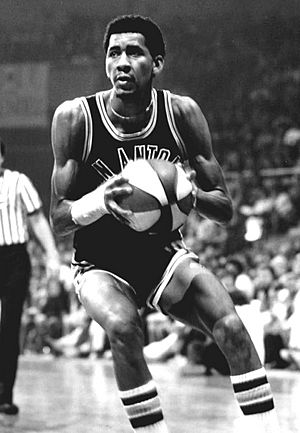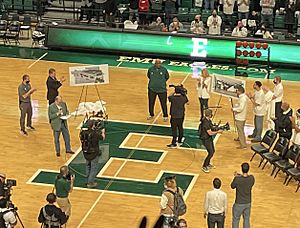George Gervin facts for kids

Gervin with the San Antonio Spurs, c. 1970s
|
|
| Personal information | |
|---|---|
| Born | April 27, 1952 Detroit, Michigan, U.S. |
| High school | Martin Luther King (Detroit, Michigan) |
| Listed height | 6 ft 7 in (2.01 m) |
| Listed weight | 180 lb (82 kg) |
| Career information | |
| College | Eastern Michigan (1970–1972) |
| NBA Draft | 1974 / Round: 3 / Pick: 40th overall |
| Selected by the Phoenix Suns | |
| Pro career | 1972–1990 |
| Coaching career | 1992–1994 |
| Career history | |
| As player: | |
| 1972–1973 | Pontiac Chaparrals |
| 1973–1974 | Virginia Squires |
| 1974–1985 | San Antonio Spurs |
| 1985–1986 | Chicago Bulls |
| 1986–1987 | Banco di Roma |
| 1989 | Quad City Thunder |
| 1989–1990 | TDK Manresa |
| As coach: | |
| 1992–1994 | San Antonio Spurs (assistant) |
| Career highlights and awards | |
|
|
| Career NBA and ABA statistics | |
| Points | 26,595 (25.1 ppg) |
| Rebounds | 5,602 (5.3 rpg) |
| Assists | 2,798 (2.6 apg) |
George Gervin (born April 27, 1952) is a famous American former professional basketball player. He was known as "the Iceman" because of his calm style of play. George Gervin played in both the American Basketball Association (ABA) and the National Basketball Association (NBA). He played for teams like the Virginia Squires, San Antonio Spurs, and Chicago Bulls. Gervin was an amazing scorer, averaging at least 14 points per game in all 14 of his seasons. He finished his NBA career with an average of 26.2 points per game. Many people consider him one of the best shooting guards in NBA history. In 1996, he was named one of the 50 Greatest Players in NBA History. Later, in 2021, he was also chosen for the NBA 75th Anniversary Team, which honors the 75 greatest players ever.
Contents
Early Life and High School Basketball
George Gervin was born in Detroit, Michigan, on April 27, 1952. He went to Martin Luther King Jr. High School. George had some struggles early on, but everything changed in his final year of high school. He grew taller and started playing much better. He averaged 31 points and 20 rebounds per game. He led his school's team to the state quarterfinals. In 1970, he was chosen as an All-State player by the Detroit Free Press.
College Basketball Journey
Gervin received a scholarship to play basketball at California State University, Long Beach. However, he found it hard to adjust to the new environment and soon returned home. He then transferred to Eastern Michigan University in Ypsilanti, Michigan. In his second year (1971–72), he was a forward and averaged an impressive 29.5 points per game. During a national semifinal game, Gervin was involved in an incident where he hit another player. Because of this, he was suspended for the next season and eventually left the team. He also lost his chances to try out for the Olympic and Pan-American teams.
Professional Basketball Career
Starting with the Pontiac Chaparrals
In the 1972–73 season, George Gervin began his professional career. He played for the Pontiac Chaparrals in Michigan. This team was part of the Continental Basketball Association.
Moving to the Virginia Squires
While playing for Pontiac, George Gervin was noticed by Johnny Kerr. Kerr was a basketball executive for the Virginia Squires in the ABA. In January 1973, Kerr signed Gervin to a contract with the Squires. He was paid $40,000 a year.
Gervin's time in Virginia was short. The Squires team often had money problems. They had to trade their best players to keep the team going. They even traded famous players like Julius Erving for money. In January 1974, Gervin was traded to the San Antonio Spurs for $228,000. The ABA tried to stop the trade, saying the Squires were selling off all their good players. But a court allowed the trade to happen. The Virginia Squires team stopped existing within two years.
Becoming a Star with the San Antonio Spurs
After playing two seasons in the ABA, George Gervin became eligible for the NBA draft in 1974. The Phoenix Suns picked him in the third round. However, Gervin chose to stay in the ABA and continued playing for the Spurs.
With Gervin as their main player, the Spurs changed their style of play. They became an exciting team that played fast-paced basketball. Even though the Spurs did not win an ABA playoff series in Gervin's first three years, their exciting offense made them popular. This helped the Spurs join the NBA in 1976, as part of the ABA–NBA merger.
In the last ABA season (1976), the Spurs had a strong team. They faced the New York Nets in the playoffs. The Nets had Julius Erving, another superstar. The Spurs pushed the series to a seventh game, but the Nets won and went on to win the championship.
Gervin won his first NBA scoring title in the 1977–78 season. He just barely beat David Thompson for the title. In the last game of that season, Thompson scored 73 points. But Gervin kept his lead by scoring 63 points in his own final game. He even set an NBA record by scoring 33 points in one quarter!
In the 1978–79 NBA season, the Spurs had a great year. They made it to the Conference Finals, which is like the semifinals of the NBA playoffs. They were up 3-1 against the Washington Bullets, meaning they needed just one more win to reach the NBA Finals. But they lost three games in a row and lost the series.
Despite not reaching the finals, Gervin remained dedicated to the Spurs. He continued to be an amazing scorer. He led the NBA in scoring for three years in a row, from 1978 to 1980. He also led the league in scoring again in 1982. Before Michael Jordan, Gervin had won more scoring titles than any other guard in NBA history.
In the 1981–82 season, the Spurs were strong contenders for a championship again. They made it back to the Conference Finals but were defeated by the Los Angeles Lakers. The Lakers went on to win the championship that year. The Spurs continued to build their team. They added players like Artis Gilmore and Mike Mitchell. In the 1982–83 season, the Spurs were once again a top team. They reached the Conference Finals but were again defeated by the Los Angeles Lakers.
Playing with the Chicago Bulls
Before the 1985–86 season, Gervin was traded to the Chicago Bulls. He joined a team with a rising star named Michael Jordan. This was Gervin's last season in the NBA. Even though he was older, Gervin still played well. He averaged 16.2 points per game and even had a game where he scored 45 points. He played in all 82 games that season. The Bulls made it to the playoffs. Gervin's last NBA game was on April 20, 1986. It was the same game where Michael Jordan scored an incredible 63 points against the Boston Celtics. The Bulls were swept by the Celtics in that playoff series.
Playing Overseas and in Other Leagues
After leaving the NBA, Gervin played basketball in Europe for several years. He played in Italy for Banco Roma during the 1986–87 season. He averaged 26.1 points per game there. He also played for the Quad City Thunder in the Continental Basketball Association (CBA) in 1989. Later, he played in Spain for the TDK Manresa team in 1989–1990. Even at 38 years old, he still had his scoring touch. He averaged 25.5 points per game and helped his team stay in the top Spanish division.
Coaching Career
Assistant Coach for the San Antonio Spurs
George Gervin returned to the Spurs as an assistant coach from 1992 to 1994. He also played in the 1992 NBA All-Star Legends Game. In that game, he scored 24 points and grabbed 11 rebounds in just 16 minutes.
George Gervin's Legacy
George Gervin was known as "Iceman" because he always seemed calm and cool on the court. He was famous for his amazing scoring ability. He also got the nickname because he rarely seemed to sweat, even when playing hard!
Gervin's special move was the finger roll. He could shoot this shot with incredible skill and from far away. Most players use the finger roll for short layups, but Gervin could make it from as far as the free-throw line!
Gervin has inspired many other athletes. Famous basketball player Gary Payton said Gervin was his childhood hero. Even former NFL quarterback Ty Detmer looked up to Gervin. Detmer wrote in his book that he was thrilled to get Gervin's autograph when he was a kid.
In 2021, to celebrate the NBA's 75th Anniversary, The Athletic ranked the top 75 players of all time. George Gervin was named the 42nd greatest player in NBA history.
Awards and Honors
George Gervin was inducted into the Naismith Memorial Basketball Hall of Fame in 1996. This is a huge honor for basketball players. His jersey number, 44, has been retired by the San Antonio Spurs. This means no other Spurs player will ever wear that number. He was also named one of the 50 Greatest Players in NBA History. In 2009, SLAM Magazine ranked him #45 on their list of the Top 50 NBA Players of All Time. In 2021, he was again recognized as one of the 75 greatest players in NBA history.
Gervin is still very involved in the San Antonio community. He has seven organizations that help kids who are not as lucky. One of these is the George Gervin Youth Center. He has said that his own childhood experiences inspired him to help others.
When he left the Spurs, he held almost all of the team's scoring records. Some of these records have since been broken by other Spurs legends like David Robinson and Tim Duncan. Gervin retired with the most blocks ever by any guard in NBA history.
Even though he was an NBA and ABA All-Star and a Hall of Famer, Gervin never played in an NBA or ABA championship series during his career.
- He is one of only four players in NBA history to average 30 points per game and shoot 50 percent from the field in a season as a guard. The others are Michael Jordan, Stephen Curry, and Shai Gilgeous-Alexander.
Life After Playing Basketball
After retiring from professional basketball, George Gervin has focused on helping his community. He started the George Gervin Youth Center in 1991. This center helps underprivileged children in San Antonio.
Personal Life and Family
George Gervin was born and grew up in Detroit, Michigan. In 1976, he married Joyce King. They later divorced in 1984 but remarried in 1985. They have three children. His oldest son, George Gervin Jr. (nicknamed "Gee"), played for the Harlem Globetrotters. He also played professionally in Mexico and Sweden. George Gervin's sister, Barbara Gervin-Hawkins, is a politician in the Texas House of Representatives. His younger brother, Derrick Gervin, was also a professional basketball player.
Images for kids
See also
 In Spanish: George Gervin para niños
In Spanish: George Gervin para niños





